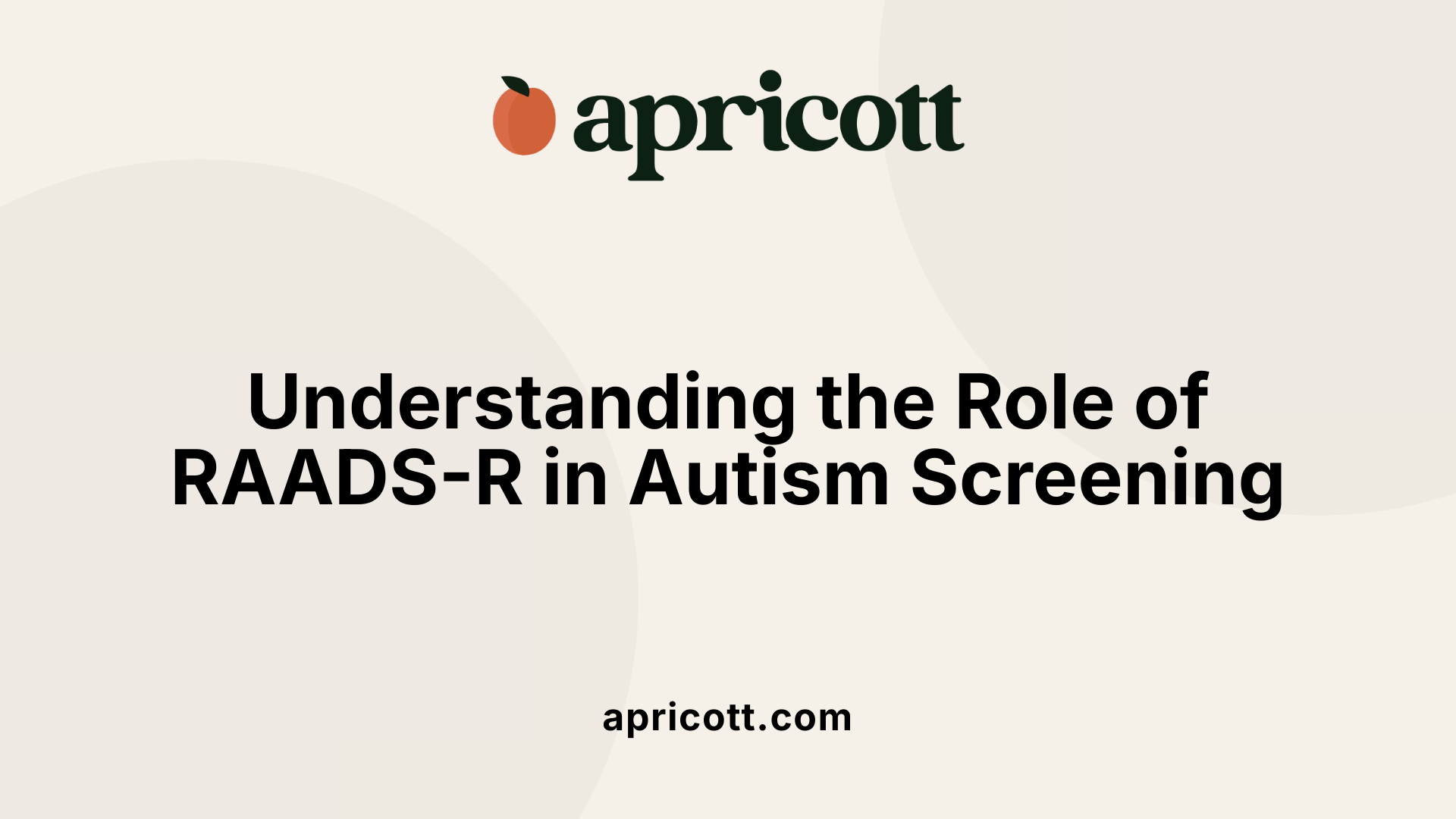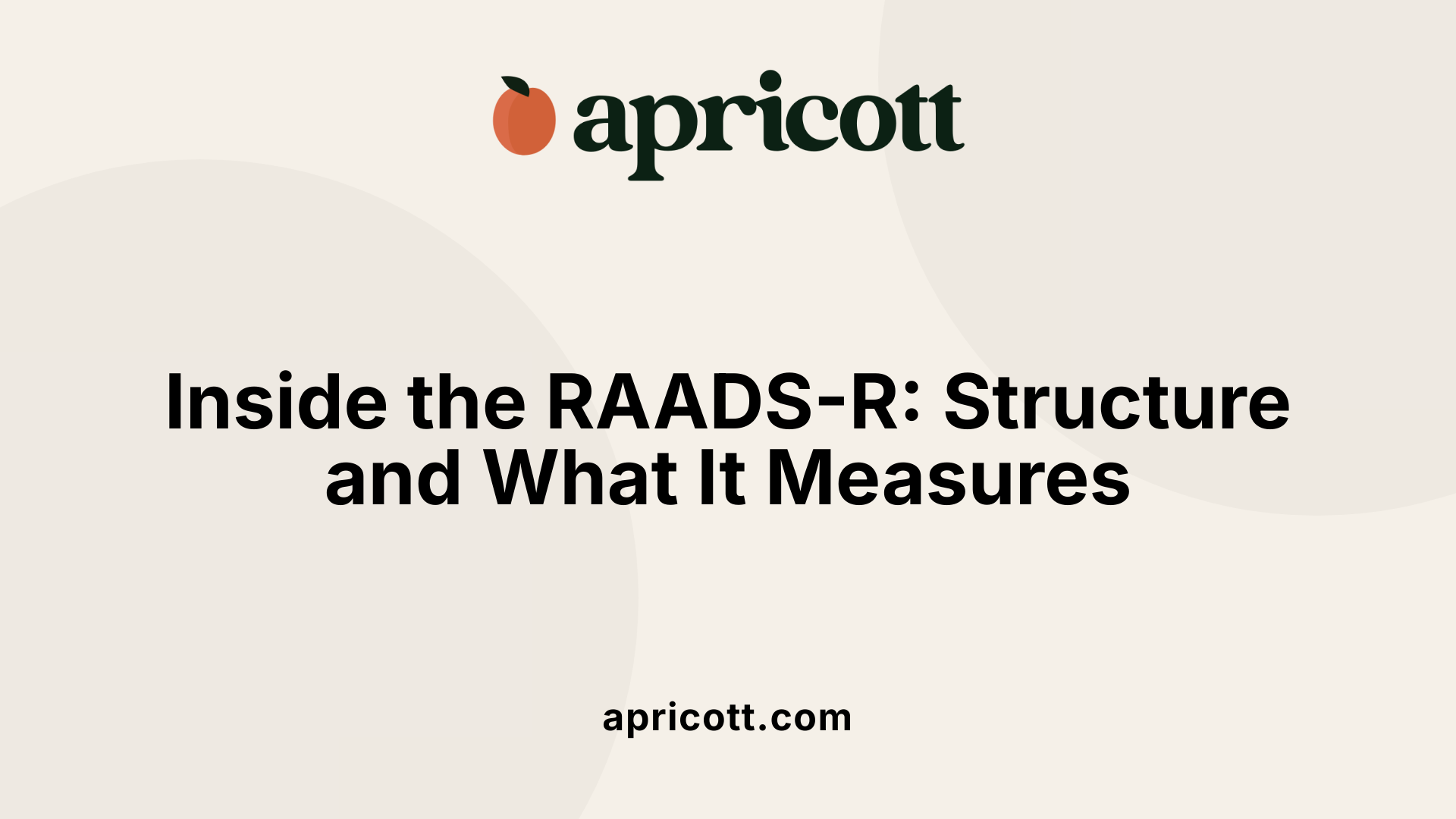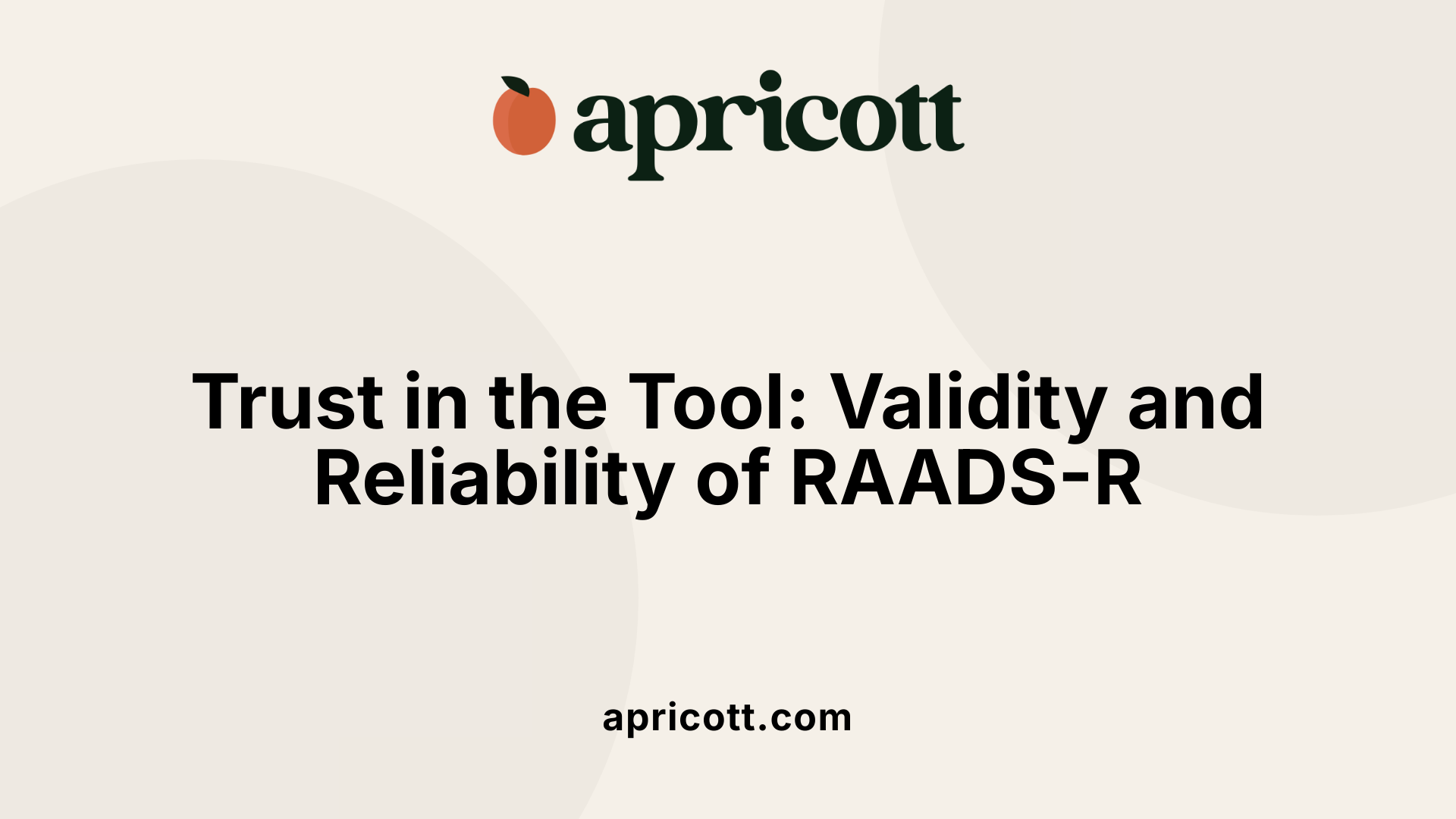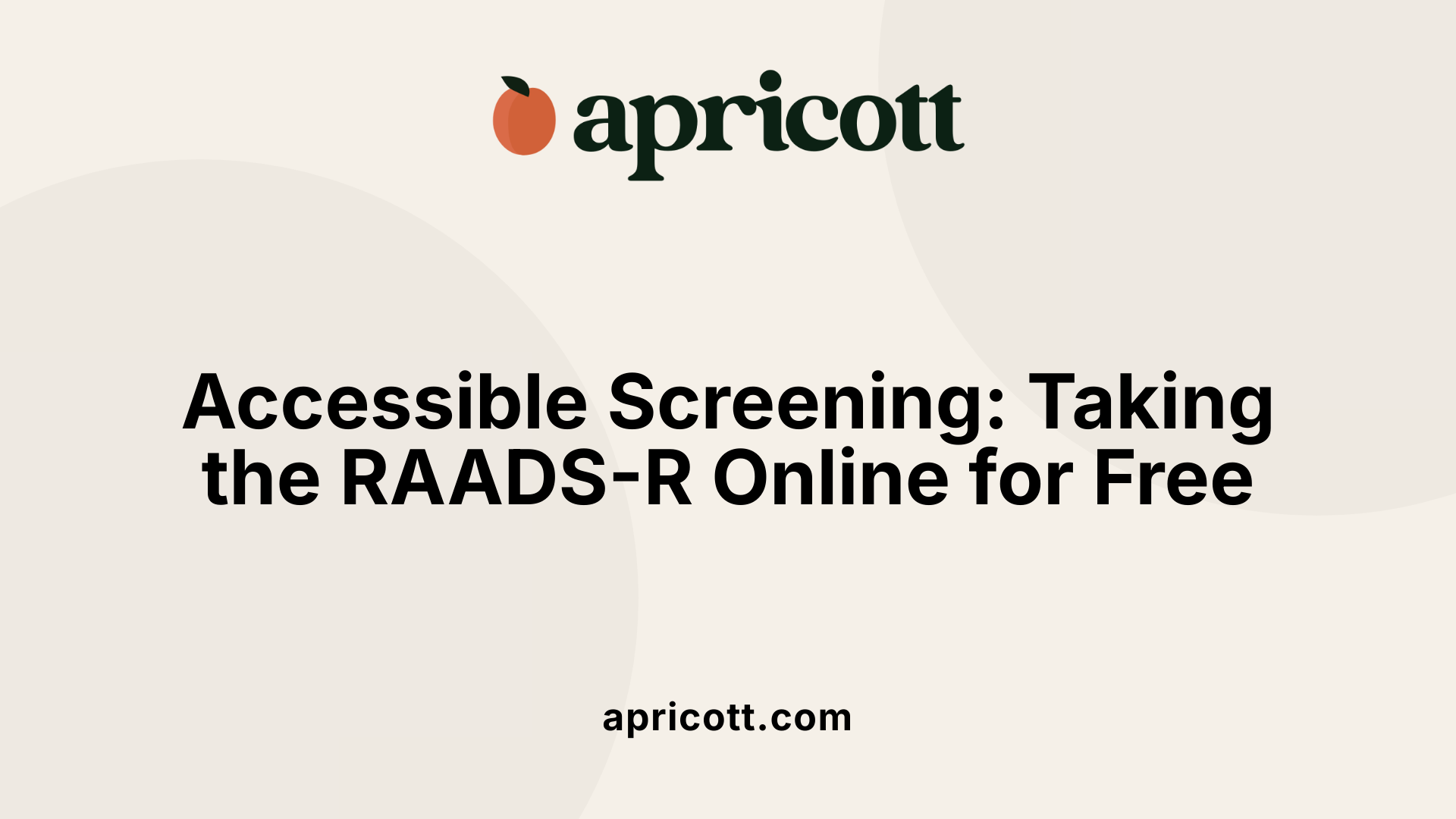August 15, 2025
Understanding the RAADS-R: A Key Tool in Autism Screening for Adults
The RAADS-R (Ritvo Autism Asperger Diagnostic Scale-Revised) is an essential screening instrument designed to help identify autism spectrum traits in adults. Its development aimed to assist clinicians in screening for autism, especially in cases where individuals may not have received an earlier diagnosis or exhibit high-functioning autism features. This article explores the purpose, structure, scoring, reliability, and the role of RAADS-R within the broader context of autism assessments for adults.
 The RAADS-R is an important tool in the assessment of autism, especially in adults. It functions primarily as a screening and supportive instrument to identify traits associated with autism spectrum disorder (ASD). This helps clinicians recognize the presence and severity of symptoms such as social interaction challenges, sensory sensitivities, and difficulties with emotional regulation.
The RAADS-R is an important tool in the assessment of autism, especially in adults. It functions primarily as a screening and supportive instrument to identify traits associated with autism spectrum disorder (ASD). This helps clinicians recognize the presence and severity of symptoms such as social interaction challenges, sensory sensitivities, and difficulties with emotional regulation.
Designed to complement detailed clinical evaluations, the RAADS-R provides a quantifiable score that guides further diagnosis. A score of 65 or higher suggests a high likelihood of autism, making it a valuable aid in cases where diagnosis might be complex, such as in high-functioning individuals or those with subtle symptoms.
The test is intended for adults aged 16 and above who do not have significant intellectual disabilities. It acts as an accessible, supportive step in understanding autism traits, often in settings where quick screening is needed. Overall, the RAADS-R supports early detection and fosters a greater understanding of autism in adults, helping facilitate tailored support and interventions.

The RAADS-R, or Ritvo Autism and Asperger Diagnostic Scale-Revised, is a comprehensive self-assessment tool designed to identify autism spectrum traits in adults. The test consists of 80 statements that explore various aspects of behaviors and experiences associated with autism.
It is organized into four major assessment domains:
These areas cover core features of autism, such as social interaction difficulties, intense interests, communication issues, and sensory sensitivities. Respondents answer each statement using a Likert scale, typically ranging from 'Never' to 'Always,' which quantifies how frequently they experience particular behaviors.
The responses are scored to generate a total score, with a threshold of 65 or higher suggesting the likelihood of autism. It is important to note that the RAADS-R is not used for a formal diagnosis but rather as a screening instrument that can support clinical evaluations.
Designed for adults aged 18 and over, the RAADS-R demonstrates high sensitivity (97%) and specificity (close to 100%) in differentiating individuals with autism from neurotypical adults. It provides valuable insights to healthcare professionals by highlighting the presence of traits associated with autism, helping to inform further diagnostic decisions when combined with clinical judgment.
 The RAADS-R test has a scoring range from 0 to 240 points. This wide range allows for detailed assessment of autism-related traits.
The RAADS-R test has a scoring range from 0 to 240 points. This wide range allows for detailed assessment of autism-related traits.
A score of 65 and above is considered indicative of a significant likelihood of autism. In the validation study, no neurotypical individuals scored higher than 64, making this cutoff a useful marker for screening purposes.
The scores are interpreted as follows: scores below 50 typically indicate few or no autistic traits, scores between 50 and 64 suggest some traits but are unlikely to signal autism, and scores of 65 or higher point to a potential presence of autism. Higher scores like 90, 130, or 160 reflect increasing severity, with scores over 200 indicating overwhelming autistic traits.
This scoring system helps distinguish those who may benefit from further clinical evaluation, emphasizing that the RAADS-R is a screening tool, not a diagnostic instrument. A healthcare professional's assessment is necessary to confirm a diagnosis. For more detailed interpretation, searching

The RAADS-R has proven to be a highly dependable instrument for screening autism spectrum disorder (ASD) in adults. It boasts a sensitivity of 97%, meaning it is extremely effective at correctly identifying those with autism. Its specificity reaching 100% indicates that it very accurately distinguishes individuals without autism, reducing false positives.
One of the notable strengths of the RAADS-R is its strong test-retest reliability, measured at r = 0.987. This suggests that the results are consistent over time, lending confidence to its stability as a screening tool.
Numerous validation studies have supported the RAADS-R’s effectiveness. These research efforts, including studies performed across international centers such as Yale, UCLA, and Monash, demonstrate that the questionnaire reliably correlates with clinical autism diagnoses.
Importantly, factors such as age, gender, or whether an individual is self-identified or formally diagnosed do not significantly impact the test’s accuracy or interpretive consistency. This broad applicability makes it a valuable preliminary step in assessing adult autism.
It is crucial to understand, however, that the RAADS-R is designed primarily to screen for autistic traits and is not a conclusive diagnostic tool. Confirmatory diagnosis should always involve a comprehensive assessment by qualified healthcare professionals.
In essence, the RAADS-R provides a scientifically validated, reliable measure for flagging potential autism in adults, facilitating early recognition and subsequent evaluation within a clinical setting.

Yes, the RAADS-R test is available online at no cost through NeuroDirect, making it accessible for adults who want to explore the possibility of autism spectrum disorder (ASD). This self-assessment tool is designed for individuals to evaluate their own traits related to autism, such as social interaction difficulties, sensory sensitivities, and emotional regulation issues.
Completing the test usually takes about 20 to 30 minutes, offering a nuanced look at patterns that tend to persist into adulthood. After finishing the questionnaire, users receive a score that suggests the likelihood of autism. For example, scores of 65 and above indicate a high possibility of ASD, while scores below 64 suggest a lower likelihood.
It’s important to remember that the RAADS-R is a screening tool, not a diagnostic instrument. A high score should prompt consultation with a qualified healthcare professional who can perform a comprehensive assessment. Only a licensed clinician can establish an official diagnosis, ensuring accurate understanding and support.
This online availability supports individuals in initial screening efforts and provides valuable insight into their traits. It also serves as a helpful step for those considering further evaluation or seeking a better understanding of their experiences. Keep in mind that while the RAADS-R aids in preliminary screening, it should always be used alongside professional advice for a definitive diagnosis.
The RAADS-R stands as a valuable screening instrument in the landscape of adult autism assessment. Its high sensitivity, broad validation, and ease of access make it an important initial step for adults seeking understanding of their neurodivergent traits. Nonetheless, it is crucial to remember that the RAADS-R is a screening tool, not a diagnostic instrument. A comprehensive clinical evaluation remains the gold standard for diagnosing autism spectrum disorder. When used appropriately within a broader diagnostic process, the RAADS-R can significantly contribute to early recognition and support for adults on the spectrum, fostering better social and psychological outcomes.